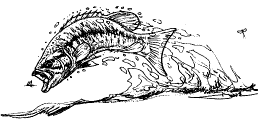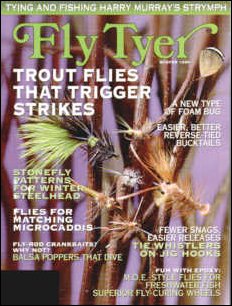
Check it Out

Headwaters:
a fish and angling art show
Here is a great selection of Hunting & Fishing magazines.
With 1200 Magazines to choose from you just can't go wrong
Help support this site by supporting our affiliates
All intellectual property and Pictures Copyright© of Robert Morger 1999. No reproductions of any material on this site is permitted without the express permission of the owner. All rights reserved.
The Onelist logo is a copyright of Onelist,Inc Copyright © 1998-1999, ONElist, Inc. All Rights
Reserved.
If you have suggestions or questions please contact rmorger@juno.com
Powered by counter.bloke.com
Nylon Mullet

Tied By Mark Delaney
Materials |
||
Hook |
Mustad 92611, 5/0 with offset straightened |
|
Thread |
White 3/0 |
|
Head |
Black closed cell poly foam 3/4" diameter |
|
Eyes |
9mm doll eyes or cats eyes |
|
Tail Assembly |
4-6 saddle hackles tied splayed |
|
Body |
White mylar metallic yarn |
|
Wing Assembly |
Soft white nylon under crimped white nylon, |
|
top with light blue nylon under light blue |
||
crimped nylon, top with black crimped nylon |
||
under black soft nylon. |
||
Gills |
Red Marabou |
|
Instructions |
||
To make the head use a piece of 3/4" id tubing sharpened |
||
at one end with a file to punch out the foam cylinders from |
||
the black closed cell polyethylene foam. To attach the foam |
||
cylinder to the hook use a hot melt glue gun using the |
||
following procedure. First use the hot tip of the glue gun to |
||
make a V-groove in the bottom of the foam cylinder. Then |
||
lay the hook in the groove and cover the hook shaft completely |
||
with hot melt glue. Let the glue dry and cure thoroughly. Then |
||
take the head and hook assembly and spray paint the bottom |
||
of the foam cylinder. The white paint will only cover the hot |
||
melt glue well, leaving a shading effect on the rest of the foam |
||
from the bottom. Take the 9 mm doll or cat eyes (I bought out |
||
every 9 mm eye in Lake Charles for this swap, that is why some |
||
of you have brown doll eyes and some have amber doll eyes |
||
and some have yellow cat eyes. After looking at the results I |
||
think I like the yellow cat eyes best, since they give the best |
||
contrast.) And using a side cutter cut about half of the shaft |
||
off. Make a hole all the way through the head in the position |
||
you want using a nail with the same approximate diameter as |
||
the shafts on the eyes. Glue the eyes in place using Goop, |
||
E-6000 or a similar type of adhesive. The head-hook assembly |
||
is now finished. Place the head hook assembly in the vise. |
||
Attach the white thread to the hook near the bend of the hook. |
||
Tie in 4-6 saddle hackles splayed at the rear of the hook. |
||
(This is referred to as the tail assembly, the wing assembly |
||
is actually much longer.) Attach a length of white Mylar metallic |
||
yarn and then advance the thread to just behind the foam head. |
||
Wrap the white metallic yarn up to just behind the foam head |
||
and tie off and trim any excess off. Next step is the construction |
||
of the wing assembly. The wing is made from two different |
||
types of nylon. One is crimped nylon which is readily available |
||
to fly tiers. The soft nylon comes from what is known as craft |
||
cord or plastic canvas yarn. This stuff is available in a myriad |
||
of colors. To get the soft nylon you need you must take the |
||
braid apart. The procedure for this is as follows. Cut a piece |
||
of craft cord about an inch longer than you need. Fray 3/4" to 1" |
||
at one end so you can see the hanks that are braided together. |
||
Grasp the fibers from one hank and pull it out of the braid while |
||
holding onto the others with the other hand. Continue until the |
||
material is completely unbraided. Most craft cord yields 8 hanks |
||
of material. Grab the number of hanks you require at one end |
||
and brush the fibers straight using a small stainless steel |
||
detail brush (don?t use a brass brush since that will discolor |
||
light colored nylon). After brushing one direction, grab the |
||
other end and brush the opposite way until you have nylon |
||
fibers that are no longer wound around each other. The craft |
||
cord is a nice source of soft nylon with a nice luster. It has the |
||
obvious advantage in that you can get soft nylon in any length |
||
that you need. To construct the wing take the white nylon from |
||
8 hanks and tie it in at the desired length. Top this with 25-50 |
||
fibers of crimped white nylon. Then tie in soft light blue nylon |
||
from 4 hanks. Top this with 15-30 fibers of crimped light blue |
||
nylon. Top this with 25-50 fibers of crimped black nylon, which |
||
is finally topped with soft black nylon from 8 hanks. The gills |
||
are red marabou tied in just behind the foam head on either side |
||
(they considerably brighten up what is a rather monochromatic fly). |
||
Although this looks like a popper, it doesn't pop very well. It does |
||
float quite well, since the nylon does not absorb water. The long |
||
wing assembly causes the fly to float on the surface of the water |
||
in the exact same position as a mullet feeding on the surface of |
||
the water, head up, mouth skimming the surface. The fly can be |
||
retrieved to make a V-wake exactly like such a feeding mullet. I |
||
have been able to cast this fly relatively well on my 12-weight |
||
(Nothing this big is going to be easy to cast!) Good luck with |
||
these monsters! |
||
Mark Delaney |
||

